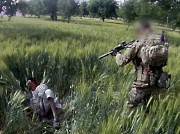|
PancakeTransmission posted:Edit: Passed the CCNA exam last week. Had some questions that were definitely not CCNA material (checked through cert guides, looked in CCNP books). I'm guessing they were the beta unmarked questions the intro mentioned. Or maybe they are mentioned in the official 3rd edition cert guides. I studied from the 2nd edition which is from 2008. They did add some questions while removing some aging questions from the pools. I think more on wireless technologies and IPv6, as well as removing some in-depth RIP material. Someone that I talked to that took their test around a year ago said that they added questions touching on Fiber and OC technologies, but I don't know how truthful that is.
|
|
|
|

|
| # ? Apr 18, 2024 08:02 |
|
hooah posted:How much of a rhyme or reason is there to the "X" part of the NBaseX naming scheme? I've noticed T for twisted pair, F for fiber, and S/L/E for shortwave/longwave/extended wave lasers, but haven't caught on to any patterns besides those. Take a look at http://www.brocade.com/downloads/documents/technical_briefs/Ethernet_Nomenclature_GA-TB-357.pdf it's got a pretty good explaination of them all. Cheradenine fucked around with this message at 14:47 on Jan 23, 2013 |
|
|
|
trunkwontopen posted:They did add some questions while removing some aging questions from the pools. I think more on wireless technologies and IPv6, as well as removing some in-depth RIP material. Someone that I talked to that took their test around a year ago said that they added questions touching on Fiber and OC technologies, but I don't know how truthful that is. When I took ICND1 in 2011 they had a few questions about SX and LH MM/SM fiber standards. On IPv6: The ROUTE book goes pretty far into depth on it, but from what I can tell (and maybe someone can confirm) the test doesn't waste your time by making you figure out the number of possible addresses. In fact at one point in first chapter on it Odom pretty much says that none of us will live to see IPv6 address exhaustion. psydude fucked around with this message at 16:58 on Jan 23, 2013 |
|
|
|
psydude posted:When I took ICND1 in 2011 they had a few questions about SX and LH MM/SM fiber standards. Currently 42 undecillion addresses (of a total 340 undecillion) are allocated for internet use. So, maybe.
|
|
|
|
We're not going to see IPv6 exhuastion... we're just going to see quadrillions of addresses wasted because entire /48 subnets will be relegated down to /126's in pager code. For example, Comcast's anycast DNSv6 IP: 2001:558:FEED::1 Oh, and my shortcut for IPv6 is every group (FFFF) is /16 worth. Just for fun, consider that every two groups is one internet's worth of addresses, and ARIN's default delegation to ISPs is /32, where every ISP customer is supposed to get a /48. code:CrazyLittle fucked around with this message at 18:15 on Jan 23, 2013 |
|
|
|
A galactic federation of aliens will contact Earth and take all our IPv6 addresses in the process. That's the only reasonable scenario I can think of.
|
|
|
|
I want each article of clothing I wear to have an IP address.
|
|
|
|
Sylink posted:I want each article of clothing I wear to have an IP address. Lets say every person on earth has 100 pieces of clothing (no way is this correct) 672 billion addresses. That's 1.62*10^-24th percent of the total number of internet allocated addresses. http://www.wolframalpha.com/input/?i=number+of+people+on+earth*100%2F+42+undecillion
|
|
|
|
Not cert related, but just out of curiosity given the discussion at hand: do you guys plan on still using unique local/private addresses for your networks once you start rolling out IPv6? I can see where it would have some definite security advantages over just using the global unicast address.
|
|
|
|
CrazyLittle posted:We're not going to see IPv6 exhuastion... we're just going to see quadrillions of addresses wasted because entire /48 subnets will be relegated down to /126's in pager code. For example, Comcast's anycast DNSv6 IP: 2001:558:FEED::1 Yeah we have I think a /28 from ARIN and a /46 from APNIC and will probably get a shitton from RIPE. I'm swimming in v6 space. It makes it actually interesting to do network architecture at least. Only thing is that a /48 right now is equal to a /24 in v4 as far as the internet. The best waste is a /64 for a point to point link instead of a /127 psydude posted:Not cert related, but just out of curiosity given the discussion at hand: do you guys plan on still using unique local/private addresses for your networks once you start rolling out IPv6? I can see where it would have some definite security advantages over just using the global unicast address. There are philosophical arguments that will state each device on your network should have a globally unique address while others will want to stick to how they've been doing networking and use private addressing. Unique addressing would be easier and I don't know what security benefits you would gain from private addressing. doomisland fucked around with this message at 20:28 on Jan 23, 2013 |
|
|
|
Fatal posted:Lets say every person on earth has 100 pieces of clothing (no way is this correct) Sweet, I'm going to have a different version of Java on each item, as well.
|
|
|
|
Any good estimate on how long IPv4 will remain the industry standard before IPv6 becomes the new standard? I've heard IPv4 will be the standard for at least another five years or more. DropsySufferer fucked around with this message at 20:53 on Jan 23, 2013 |
|
|
|
DropsySufferer posted:Any good estimate on how long IPv4 will remain the industry standard before IPv6 becomes the new standard? I've heard IPv4 will be the standard for at least another five years or more. As long as it takes for people to ditch their old routers and firewalls. Five years is a modest estimate. I think it will be in wide use in five years, but probably won't overtake IPv4 universally for seven or more years. There are people who are still using IPX/SPX for their LAN protocols. doomisland posted:The best waste is a /64 for a point to point link instead of a /127 Yeah, I forget why but I still use /30 (and /126) for all my point to point links. There was some argument against using a /31 but it probably hinged on compatibility with lovely customer hardware. CrazyLittle fucked around with this message at 20:45 on Jan 23, 2013 |
|
|
|
doomisland posted:There are philosophical arguments that will state each device on your network should have a globally unique address while others will want to stick to how they've been doing networking and use private addressing. Unique addressing would be easier and I don't know what security benefits you would gain from private addressing. I was thinking that one advantage it would have is making it harder for an attacker to map your network topology and determine the address of a target machine or machines.
|
|
|
|
DropsySufferer posted:Any good estimate on how long IPv4 will remain the industry standard before IPv6 becomes the new standard? I've heard IPv4 will be the standard for at least another five years or more. Well, technically speaking the RIR's can get no more v4 address space. APNIC is on their last /8 which means they're on stage 3 of their IPv4 exhaustion plan. RIPE is on their last /8. ARIN has a little over 2 /8's though at least. As far as industry standard all the ISPs at least are probably 1-3 years out from full v6 and if they're not they're poo poo. Comcast is the most ahead from what I can tell. They've been upgrading their CMTS equipment last I knew to handle IPv6. They also have a handy blog http://www.comcast6.net/ Each of of the RIRs have plans for exhaustion and such on their sites: http://www.ripe.net/internet-coordination/ipv4-exhaustion https://www.arin.net/resources/request/ipv4_countdown.html http://www.apnic.net/community/ipv4-exhaustion http://www.lacnic.net/en/web/lacnic/reporte-direcciones-ipv4 http://afrinic.net/en/services/statistics/ipv4-exhaustion CrazyLittle posted:As long as it takes for people to ditch their old routers and firewalls. Five years is a modest estimate. I think it will be in wide use in five years, but probably won't overtake IPv4 universally for seven or more years. There are people who are still using IPX/SPX for their LAN protocols. You're wasting two IPs using /126 :p doomisland fucked around with this message at 20:50 on Jan 23, 2013 |
|
|
|
One thing about subnetting has been confusing as well since we are still kinda on that topic. Does the the ip address class in relation to the subnet class matter? For example 10.0.0.0 can use a class A mask /8 or B /16 or C /24. It doesn't matter and I've read no rules restricting use. 192.0.0.0 can do the same in fact for purposes of subneting 192.0.0.0 seems to be the same as 10.0.0.0 not counting that 190.0.0.0 is a public address. Am I free to break the association between IP class and the subnet class from my head or there is a rule I missed? In fact it seems like any address could use any mask provided the LAST 3 octets started at 0. The class A,B,C thing for subnet masks feels like a misnomer or am I misunderstanding? DropsySufferer fucked around with this message at 20:58 on Jan 23, 2013 |
|
|
|
DropsySufferer posted:Am I free to break the association between IP class and the subnet class from my head or there is a rule I missed?
|
|
|
|
Yah I'm reading the Todd lammle book and all the classful poo poo is obnoxious because they will have a network diagram using a faithful classful architecture but everything is actually in CIDR.
|
|
|
|
CrazyLittle posted:Yeah, I forget why but I still use /30 (and /126) for all my point to point links. There was some argument against using a /31 but it probably hinged on compatibility with lovely customer hardware. I thought you can't do /31, at least not with IPv4? Also are you really "wasting" IPs since you need a network address and a broadcast address anyway?
|
|
|
|
Inspector_71 posted:I thought you can't do /31, at least not with IPv4? Also are you really "wasting" IPs since you need a network address and a broadcast address anyway? /31 is supported for Point to Point links on a lot of commercial-grade hardware.
|
|
|
|
psydude posted:/31 is supported for Point to Point links on a lot of commercial-grade hardware. Interesting. I assume the equipment just ignores the "requirement" for a broadcast address since it's not really necessary?
|
|
|
|
DropsySufferer posted:Any good estimate on how long IPv4 will remain the industry standard before IPv6 becomes the new standard? I've heard IPv4 will be the standard for at least another five years or more. I was under the impression IPv4 would essentially last forever as it's backwards compatible. Would you not have corporate networks NAT'd with 10.0.0.0 internally?
|
|
|
|
psydude posted:/31 is supported for Point to Point links on a lot of commercial-grade hardware. Yeah Inspector_71 posted:Interesting. I assume the equipment just ignores the "requirement" for a broadcast address since it's not really necessary? It's not like the traffic's going anywhere else on that link 
|
|
|
|
Since I was actually looking this topic up just a few weeks ago, here's the RFC for it. RFC 3021. It is only a proposed standard despite being written in RFC 12 years ago and being implemented by Cisco devices since 2001. I guess they're focusing more on IPv6 at this point! Imagine all the IPs that could have been saved... But I guess a lot of older hardware wouldn't support it.
|
|
|
|
psydude posted:So go forth and enjoy your 192.168.5.0/23 address scope. Don't you mean 192.168.4.0/23 address scope? 192.168.5.0/23 is just an ip address. doomisland posted:The best waste is a /64 for a point to point link instead of a /127 Jelmylicious fucked around with this message at 13:36 on Jan 24, 2013 |
|
|
|
Jelmylicious posted:Don't you mean 192.168.4.0/23 address scope? 192.168.5.0/23 is just an ip address. Yeah, looks like I fat fingered that one.
|
|
|
|
I've started the portion of the Lammle book on subnetting (Class B, specifically), and am somewhat confused on his implementation of the method for finding how many subnets you have. Up to /24, he was subtracting the 3rd octet from 256, which made sense because the 4th was still 0. But when he got to /25, he subtracted the 3rd, and moved to the 4th octet at /26. Why is the divide /25 to /26, rather than /24 to /25?
|
|
|
|
hooah posted:I've started the portion of the Lammle book on subnetting (Class B, specifically), and am somewhat confused on his implementation of the method for finding how many subnets you have. Up to /24, he was subtracting the 3rd octet from 256, which made sense because the 4th was still 0. But when he got to /25, he subtracted the 3rd, and moved to the 4th octet at /26. Why is the divide /25 to /26, rather than /24 to /25? Sounds like a misprint. Basically, you subtract the octet that is not 255 or 0, and work with that. Have you downloaded the errata?
|
|
|
|
Jelmylicious posted:Sounds like a misprint. Basically, you subtract the octet that is not 255 or 0, and work with that. Have you downloaded the errata? Where is the errata? The only download I saw on the website is the zip with the study program.
|
|
|
|
hooah posted:Where is the errata? The only download I saw on the website is the zip with the study program. I basically assumed* that there would be errata, because any technical book needs them. No author or editor is infallible. It might say something about errata in the introduction of your book. I couldn't find any for you either. *<insert standard remark about assumptions>
|
|
|
|
I work in medicine currently. Before that, I worked in really low level IT. Helpdesk/Off-Site Tech type stuff. With about a 5-6 year gap between then and now, even if I finish the cert/degree train (A+, N+, S+ all done, studying VMWare currently) is there going to be a glaring lack of experience when I go for interviews? I'm not looking to fall face-first into six figures or anything, but a man's gotta eat.
|
|
|
|
What is medicine? Like are you a doctor or what.
|
|
|
|
Scheduled 220-801 and 220-802 for tomorrow after realizing that 70% of the A+ is random poo poo I already know and the rest is printers apparently. Got my final resume draft from DustingDuvet yesterday and it looks loving awesome, just gotta add the A+ in to it when I pass (or apply to Subway if I don't) and proper job search starts Monday!
|
|
|
|
|
With all the sub-netting talk going on, this is something I've never fully understood. Which leads me to ask - what did you guys read or watch to learn subnetting? There are unbelievable amount of resources but what did you find was the most helpful?
|
|
|
|
Todd Lammle's CCNA book has a good explanation chapter.
|
|
|
|
Tab8715 posted:With all the sub-netting talk going on, this is something I've never fully understood. Which leads me to ask - what did you guys read or watch to learn subnetting? There are unbelievable amount of resources but what did you find was the most helpful? Lotsa practice. Also by remembering that /8 = 255.0.0.0, /16 = 255.255.0.0, and /24 = 255.255.255.0. From there, it's a lot easier to determine the hostmask and possible subnets.
|
|
|
|
Even knowing that one of the examples in Lammle's Network+ has a typo, I'm still having a hard time figuring out Class B subnetting. I got Class C just fine using Lammle's five questions, but once I get into that third octet, I get confused.
|
|
|
|
There are several ways of understanding subnetting; you may have to look around for a technique that makes sense. Multiplication works for me: Class A /8: 256 256x256x256 Class B /16: 256x256 256x256 /18: 256x256x4 64x256
|
|
|
|
Contingency posted:There are several ways of understanding subnetting; you may have to look around for a technique that makes sense. I ...what?
|
|
|
|

|
| # ? Apr 18, 2024 08:02 |
|
They teach kids to add these days by giving them a bunch of beads. By having the kids physically move the beads from pile to pile, children can see how addition works on a fundamental level. Well, with subnetting, each bead is a bit that is a power of two. One pile of beads is the network bits, and the other host bits. If you don't understand this explanation, then find another, or stare at a subnetting chart till your eyes fall out.
|
|
|
























